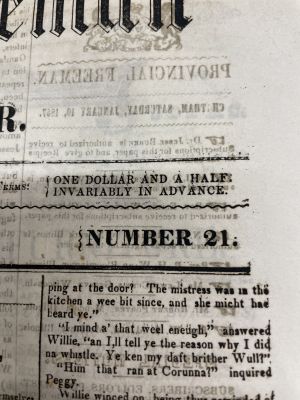The Provincial Freeman and weekly advertiser: Difference between revisions
No edit summary |
No edit summary |
||
| Line 4: | Line 4: | ||
==How They Got to The University of Pennsylvania== | ==How They Got to The University of Pennsylvania== | ||
The University of Pennsylvania has the most issues of The Provincial Freeman and weekly advertiser. There are not many owners of the original copies of the newspaper, which were normally two pages, front and back, with seven columns per page. The collection of newspapers was gathered by [https://en.wikipedia.org/wiki/William_Still Mr. William Still]. He most likely received his copies of the newspapers via the mail, as he lived in Philadelphia. His collection was given to the University of Pennsylvania in 1914 by F.E. Still, one of William Still’s relatives <ref> Murray, Alexander L. “The Provincial Freeman: A New Source for the History of the Negro in Canada and the United States.” The Journal of Negro History, vol. 44, no. 2, 1959, pp. 123–35, https://doi.org/10.2307/2716034. </ref>. | The University of Pennsylvania has the most issues of The Provincial Freeman and weekly advertiser. There are not many owners of the original copies of the newspaper, which were normally two pages, front and back, with seven columns per page. The collection of newspapers was gathered by [https://en.wikipedia.org/wiki/William_Still Mr. William Still]. He most likely received his copies of the newspapers via the mail, as he lived in Philadelphia. His collection was given to the University of Pennsylvania in 1914 by F.E. Still, one of William Still’s relatives <ref> Murray, Alexander L. “The Provincial Freeman: A New Source for the History of the Negro in Canada and the United States.” The Journal of Negro History, vol. 44, no. 2, 1959, pp. 123–35, https://doi.org/10.2307/2716034. </ref>. | ||
===The Pages of the Newspapers=== | ===The Pages of the Newspapers=== | ||
The newspapers are made out of super large, flimsy, and fragile paper so it would have been hard to preserve the newspapers over a long period of time. This explains why the newspapers are not in great condition. Between being shipped to the United States from Canada and being printed close to two centuries ago, it is clear why many of the pages are ripped and worn down. Newspapers in the 19th century were commonly printed very large because it was less expensive to print larger pages that could also include many advertisements. Every page in the newspaper is filled with advertisements, which helped fund the newspapers for around three years. Also, subscribers paid “one dollar and a half” in advance to receive the newspaper, which also helped fund it. | The newspapers are made out of super large, flimsy, and fragile paper so it would have been hard to preserve the newspapers over a long period of time. This explains why the newspapers are not in great condition. Between being shipped to the United States from Canada and being printed close to two centuries ago, it is clear why many of the pages are ripped and worn down. Newspapers in the 19th century were commonly printed very large because it was less expensive to print larger pages that could also include many advertisements. Every page in the newspaper is filled with advertisements, which helped fund the newspapers for around three years. Also, subscribers paid “one dollar and a half” in advance to receive the newspaper, which also helped fund it. | ||
[[File:Subscribe.jpeg|center|thumb|300px|Front Page of Provincial Freeman and weekly advertiser]] | |||
Revision as of 19:15, 4 May 2022
Overview
The Provincial Freeman and weekly advertiser, is a collection of weekly newspapers from 1854-1857 published by Mary Ann Shadd Clad. The newspapers were written by different Black people, published in Canada, and preach freedom and equality for Black people in North America. The largest collection of the newspapers belong to the University of Pennsylvania.
How They Got to The University of Pennsylvania
The University of Pennsylvania has the most issues of The Provincial Freeman and weekly advertiser. There are not many owners of the original copies of the newspaper, which were normally two pages, front and back, with seven columns per page. The collection of newspapers was gathered by Mr. William Still. He most likely received his copies of the newspapers via the mail, as he lived in Philadelphia. His collection was given to the University of Pennsylvania in 1914 by F.E. Still, one of William Still’s relatives [1].
The Pages of the Newspapers
The newspapers are made out of super large, flimsy, and fragile paper so it would have been hard to preserve the newspapers over a long period of time. This explains why the newspapers are not in great condition. Between being shipped to the United States from Canada and being printed close to two centuries ago, it is clear why many of the pages are ripped and worn down. Newspapers in the 19th century were commonly printed very large because it was less expensive to print larger pages that could also include many advertisements. Every page in the newspaper is filled with advertisements, which helped fund the newspapers for around three years. Also, subscribers paid “one dollar and a half” in advance to receive the newspaper, which also helped fund it.

- ↑ Murray, Alexander L. “The Provincial Freeman: A New Source for the History of the Negro in Canada and the United States.” The Journal of Negro History, vol. 44, no. 2, 1959, pp. 123–35, https://doi.org/10.2307/2716034.